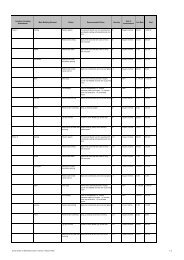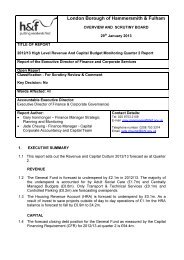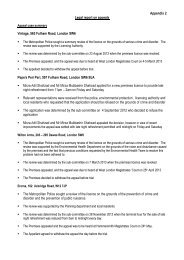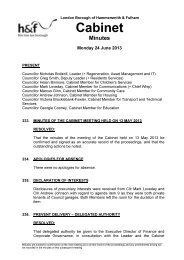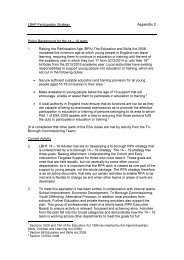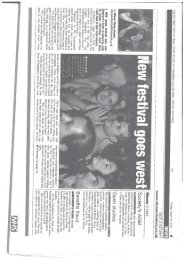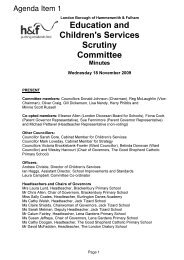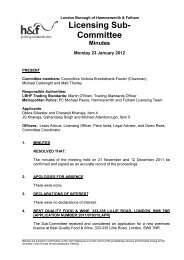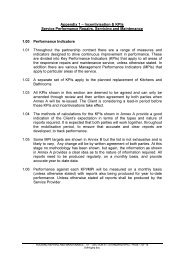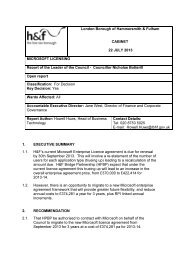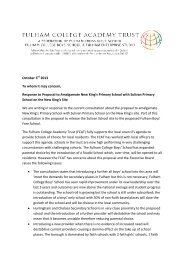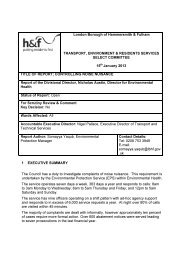Planning Applications PDF 1 MB - Meetings, agendas and minutes
Planning Applications PDF 1 MB - Meetings, agendas and minutes
Planning Applications PDF 1 MB - Meetings, agendas and minutes
You also want an ePaper? Increase the reach of your titles
YUMPU automatically turns print PDFs into web optimized ePapers that Google loves.
3.12 It is noted that the existing site which fronts on to South Africa Road is already<br />
surrounded by 4m-high mesh fencing <strong>and</strong> 12 floodlighting columns which are 8m in<br />
height. Parts of the existing fencing are in poor repair with breaks having been made to<br />
gain access into the facilities. Therefore, whilst the appearance of this piece of l<strong>and</strong><br />
would change, it is not considered that the character of the area, which is already used<br />
as fenced sports pitches, would be significantly altered, <strong>and</strong> the appearance of the site<br />
would be improved.<br />
3.13 Comments have been received relating to the relationship of the site with the<br />
rest of Hammersmith Park, <strong>and</strong> saying that the proposed development fails to be in<br />
keeping with the Japanese Garden of Peace. However, it is considered that like many<br />
public parks, Hammersmith Park has distinct areas: here there is the l<strong>and</strong> used for<br />
formalised sports pitches, <strong>and</strong> there is also the l<strong>and</strong>scaped part of the park which is<br />
valued for its visual amenity <strong>and</strong> used for less formal leisure <strong>and</strong> recreation. As detailed<br />
above, there is no objection in l<strong>and</strong> use terms to the replacement of the existing sports<br />
facilities with a similar use. The two parts of the park are visually <strong>and</strong> functionally<br />
distinct, <strong>and</strong> since the proposed pavilion relates to the sports pitches it is not considered<br />
that there is a need or desire for it to respond architecturally to the Japanese garden.<br />
The interior of the building could reflect the history of the site, such as incorporating<br />
photographs of the Japanese garden <strong>and</strong>/or the 1910 exhibition. Details of this would be<br />
conditioned (Condition 35).<br />
3.14 It is therefore considered that the proposals are satisfactory in terms of design<br />
<strong>and</strong> would not detrimentally impact on the existing character <strong>and</strong> appearance of the<br />
park or the wider conservation area. The proposals are therefore considered to comply<br />
with Policies BE1 <strong>and</strong> DMG7.<br />
3.15 Hammersmith Park is designated as a nature conservation area, although this<br />
designation does not extend to the existing sports pitches at South Africa Road.<br />
However, a small part of the application site (110 sqm on the south western boundary)<br />
falls within the nature conservation area. Policy DM E3 of the Local Plan states that<br />
nature conservation areas will be protected from development which is likely to cause<br />
demonstrable harm to their ecological (species <strong>and</strong> habitats) value. In addition, Policy<br />
DM E1 states that developments should be refused which have an adverse impact on<br />
biodiversity. In this instance, the part of the site which is designated as part of the<br />
nature conservation area is a grassy piece of l<strong>and</strong> behind the existing changing room<br />
block, with two Cherry trees. As part of the applicant's submission, an Arboricultural<br />
survey has been undertaken, assessing the health <strong>and</strong> quality of the trees on the site.<br />
The two Cherry trees are assessed as Category 'U' (sometimes known as Category 'R'),<br />
which means that they are poor quality specimens with a life span of less than 10 years.<br />
Whilst these trees are proposed to be removed, they are likely to die or require removal<br />
in the next ten years, <strong>and</strong> as part of the proposal they would be replaced with new trees<br />
(see further below).<br />
3.16 The applicants have also submitted information about the effect of the<br />
development on protected species, <strong>and</strong> especially the impact of the proposed<br />
floodlighting on bats. It should be noted that the existing site has floodlighting around<br />
the main sports pitch, although it is acknowledged that the extent of the lighting would<br />
be increased. Floodlighting has the effect of deterring some light avoiding bat species<br />
such as Barbastelle <strong>and</strong> Greater <strong>and</strong> Lesser Horseshoe bats, but other species (such<br />
as Pipistrelle bats) would be attracted due to the fact that insects are attracted to the<br />
lights. Due to the urban location, the species most likely to occur here would be the



